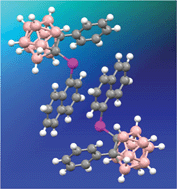Synthesis, structural, spectroscopic and electrochemical studies of carborane substituted naphthyl selenides†
Abstract
New unsymmetrical

* Corresponding authors
a
Institut de Ciència de Materials de Barcelona, , Bellaterra, Barcelona, Spain
E-mail:
clara@icmab.es
b Department of Material Science and Chemistry, Faculty of Systems Engineering, Wakayama University, 930 Sakaedani, Wakayama, Japan
New unsymmetrical

 Please wait while we load your content...
Something went wrong. Try again?
Please wait while we load your content...
Something went wrong. Try again?
O. Guzyr, C. Viñas, H. Wada, S. Hayashi, W. Nakanishi, F. Teixidor, A. V. Puga and V. David, Dalton Trans., 2011, 40, 3402 DOI: 10.1039/C0DT01658F
To request permission to reproduce material from this article, please go to the Copyright Clearance Center request page.
If you are an author contributing to an RSC publication, you do not need to request permission provided correct acknowledgement is given.
If you are the author of this article, you do not need to request permission to reproduce figures and diagrams provided correct acknowledgement is given. If you want to reproduce the whole article in a third-party publication (excluding your thesis/dissertation for which permission is not required) please go to the Copyright Clearance Center request page.
Read more about how to correctly acknowledge RSC content.
 Fetching data from CrossRef.
Fetching data from CrossRef.
This may take some time to load.
Loading related content
